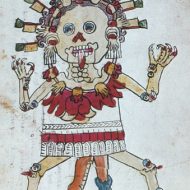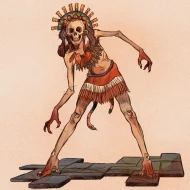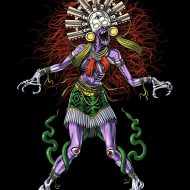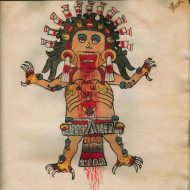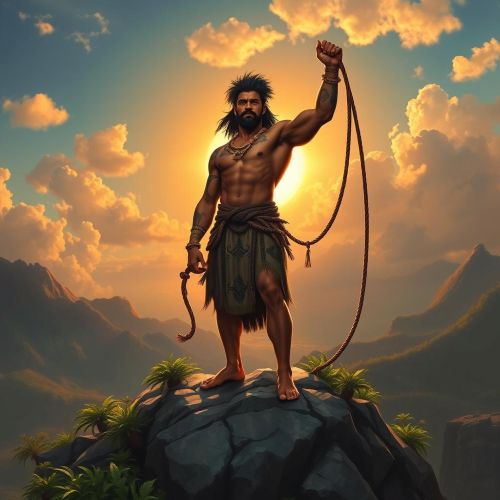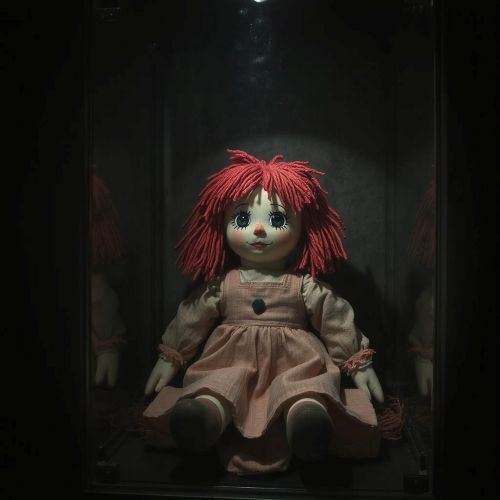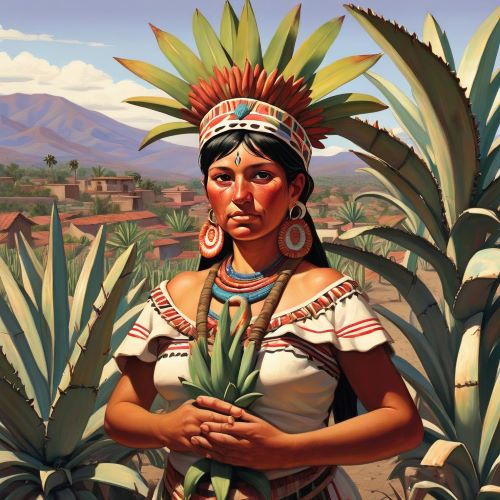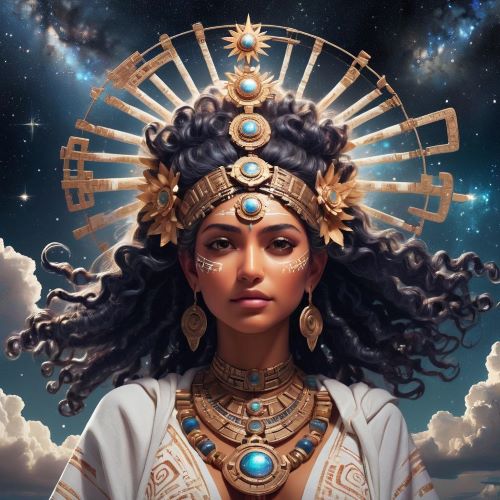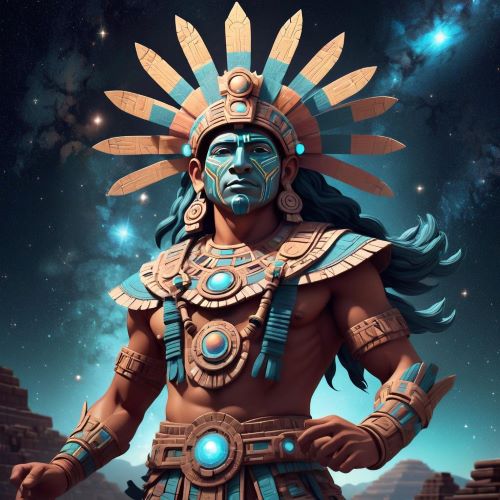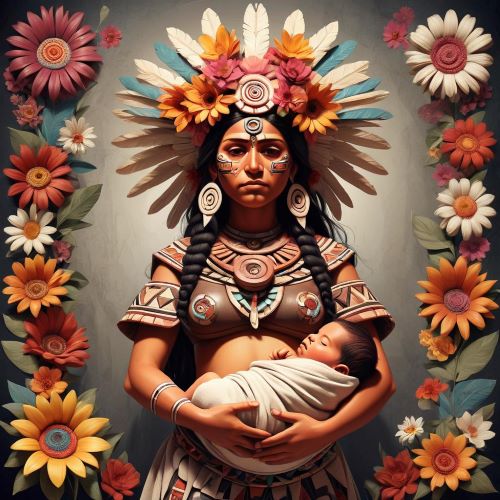Tzitzimitl : The Eclipse Stars
Listen
At a glance
| Description | |
|---|---|
| Origin | Aztec Mythology |
| Classification | Gods |
| Family Members | Xochitl-Ichcauhzo, Chalchiuhtlicue (Sisters0 |
| Region | Mexico |
| Associated With | Stars, Fertility |
Tzitzimitl
Introduction
The Tzitzimitl, frequently characterized as a monstrous deity, occupies a significant role in Aztec mythology. These deities, associated with stars, are portrayed as skeletal female figures, often donning skirts adorned with skull and crossbones designs. Despite post-conquest descriptions categorizing them as “demons” or “devils,” such labels may not accurately capture their role in the pre-Hispanic belief system of the Aztecs. These skeletal star demons, represented as women with insatiable appetites and razor-sharp claws, lingered on the periphery of the Aztec cosmos, awaiting the opportune moment to descend upon humanity. However, their existence was far more intricate than mere monstrous caricatures.
Physical Traits
Tzitzimitl manifest as skeletal female figures, frequently adorned in skirts featuring skull and crossbones designs. Their association with the stars, particularly those visible around the Sun during a solar eclipse, is prominent in Aztec mythology. Some texts describe them as entities devoid of flesh, existing solely as bone. In contrast to the vibrant deities in the Aztec pantheon, these emaciated forms stand out. Their bony fingers extend razor-sharp claws, honed on celestial debris, serving as a constant reminder of their insatiable hunger. Glinting with a macabre gleam, jagged teeth line their gaping maws, poised to devour anyone in their path. Skirts made from rattling bones or adorned with star patterns drape their lower bodies, whispering tales of the celestial realm.
Yet, within their formidable appearance, traces of their celestial origins shimmer. Their eyes, often depicted as glowing stars, radiate an otherworldly light, linking them to the cosmic dance above. Their skeletal forms, stripped of flesh, may symbolize not only death but also the perpetual cycle of decay and regeneration inherent in the natural world. These demons, forged by stars, though terrifying, are an integral part of the celestial tapestry, representing the duality of creation and destruction forever woven into the fabric of the cosmos.
Family
The Tzitzimimeh, depicted as female deities, were intricately linked to fertility and shared associations with other female divinities like the Cihuateteo, Tlaltecuhtli, Cōātlīcue, Citlālicue, and Cihuacōātl. They held a special reverence among midwives and women in labor. At the helm of the Tzitzimimeh was the goddess Itzpapalotl, who governed Tamoanchan, the celestial paradise they called home. Rather than a singular entity, the Tzitzimimeh constituted a vast celestial sisterhood, each personifying a distinct star or constellation.
Their unique powers, derived from the essence of their celestial counterparts, converged into a formidable force capable of unsettling the very foundations of the world. Chief among them was Itzpapalotl, the “Obsidian Butterfly,” a formidable goddess equipped with obsidian blades and iridescent butterfly wings, leading the charge against humanity during cosmic vulnerabilities.
Other noteworthy members included Xochitl-Ichcauhzo (“Flower-Face, Obsidian Claw”), whose beauty concealed a lethal touch, and Chalchiuhtlicue (“Precious Jade Skirt”), whose jade skirt held the ability to sap the life force from her victims. Each Tzitzimitl, distinguished by her celestial essence, contributed to the chilling symphony of destruction that marked their descent upon the earth.
Other names
Besides Tzitzimitl, this deity is alternatively recognized as the “Sozzled Grandmother Demon from Space.” In certain contexts, Tzitzimitl is labeled as a demon or devil. While the Tzitzimimeh are commonly depicted as formidable destroyers, their narrative unfolds with unexpected intricacies. They are also identified as the Ciuateteo, the “Divine Women,” and assumed the role of guardians for women who passed away during childbirth. In this capacity, they were perceived as formidable, nurturing figures guiding these departed women to paradise, elevating them to become celestial protectors alongside the Tzitzimimeh.
Powers and Abilities
The Tzitzimimeh instilled fear due to their destructive roles in the cosmic order. They were believed to instigate solar eclipses by assaulting the Sun, descending to the earth and allegedly taking possession of men during such celestial events. It was rumored that if the Tzitzimimeh failed to ignite a sacred fire in the hollow chest cavity of a sacrificed human at the conclusion of a 52-year calendar round, the fifth sun would conclude, and they would descend to consume the last remnants of humanity.
Their ominous presence extended to other foreboding periods in the Aztec world, such as the five unlucky days known as Nemontemi. The chilling echoes of their shrieks, akin to fractures in the night sky, were believed to tear at the very fabric of reality. Wielding skeletal claws crafted from stardust, they could effortlessly rend through flesh and bone. Some possessed the ability to drain the life force from their victims, leaving behind desiccated husks devoid of vitality. During celestial events of significance, like solar eclipses or the conclusion of an Aztec calendar cycle, the Tzitzimimeh’s power intensified, heightening the peril they posed to humanity.
Modern Day Influence
The influence of the Tzitzimitl extends into modern culture through various avenues. Notably, the Tzitzimitl is among the eight global monsters featured as antagonists in the Be Cool, Scooby-Doo! episode titled “Mysteries On The Disorient Express.” In the roguelike game Dungeon Crawl Stone Soup, Tzitzimitl is portrayed as a formidable high-level demon. Additionally, the Tzitzimitl make appearances as recurring antagonists in the Cartoon Network series Victor and Valentino.
Beyond mere entertainment, their narrative serves as a cautionary tale, prompting reflection on the delicate equilibrium between creation and destruction inherent in the universe, and the frailty of our existence within it. Scholars draw parallels between the Tzitzimimeh’s dread of cosmic instability and contemporary concerns about climate change and environmental degradation, emphasizing the enduring relevance of these ancient myths in our modern world.
Related Images
Frequently Asked Questions
What is lorem Ipsum?
I am text block. Click edit button to change this text. Lorem ipsum dolor sit amet, consectetur adipiscing elit. Ut elit tellus, luctus nec ullamcorper mattis, pulvinar dapibus leo.
What is lorem Ipsum?
I am text block. Click edit button to change this text. Lorem ipsum dolor sit amet, consectetur adipiscing elit. Ut elit tellus, luctus nec ullamcorper mattis, pulvinar dapibus leo.
What is lorem Ipsum?
I am text block. Click edit button to change this text. Lorem ipsum dolor sit amet, consectetur adipiscing elit. Ut elit tellus, luctus nec ullamcorper mattis, pulvinar dapibus leo.
What is lorem Ipsum?
I am text block. Click edit button to change this text. Lorem ipsum dolor sit amet, consectetur adipiscing elit. Ut elit tellus, luctus nec ullamcorper mattis, pulvinar dapibus leo.
What is lorem Ipsum?
I am text block. Click edit button to change this text. Lorem ipsum dolor sit amet, consectetur adipiscing elit. Ut elit tellus, luctus nec ullamcorper mattis, pulvinar dapibus leo.

